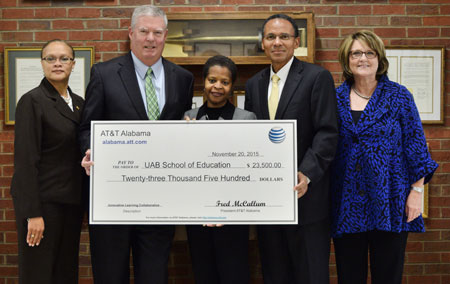Written by: Tiffany Westry
Need more info? Contact us
 With a $23,500 contribution from AT&T Alabama, the University of Alabama at Birmingham’s work to improve college readiness for students at Birmingham’s A.H. Parker High School through the UAB Innovative Learning Collaborative will continue for a second year.
With a $23,500 contribution from AT&T Alabama, the University of Alabama at Birmingham’s work to improve college readiness for students at Birmingham’s A.H. Parker High School through the UAB Innovative Learning Collaborative will continue for a second year.
The UAB Innovative Learning Collaborative is a partnership between the UAB School of Education and Birmingham City Schools that is working to form a learning community to improve education and benefits for students and faculty.
The ILC, which began with programs in Glen Iris Elementary and EPIC Elementary, expanded to A.H. Parker High School through a pilot program launched in 2014 to improve writing skills. The program focuses on ACT preparation with students in Parker’s Academy of Urban Educators. Starting with traditional writing tools, then later introducing electronic tablets preloaded with reading and writing tools, high school sophomores, juniors and seniors are shown how to improve writing, comprehension and critical thinking skills, resulting in stronger preparation for test taking.
“This continued support from AT&T Alabama gives us the opportunity to build on what we’ve started,” said Tonya Perry, Ph.D., associate professor in the Department of Curriculum and Instruction and director of the UAB Center for Urban Education. “It’s through this concerted effort that the program will make the impact we desire for the students. The funding will allow us to address some important needs, including a coordinator support position, to help facilitate and streamline communication among the school, university and stakeholders to ensure that we are maximizing our resources.”
In its first year, the program has seen success. Perry and her students use teaching techniques that are adaptable to real-world tasks. Not only is the use of technology an aid to improve literacy skills, the instruction is adapted to include other areas of study to enhance the students’ problem-solving abilities. This collaborative learning environment and hands-on, real-world application with technology are giving students an edge when pursuing postsecondary education and entering the job market.
| “We are pleased to support the UAB Innovative Learning Collaborative, a unique learning program that enriches students, graduate students and student-teachers’ lives,” said Fred McCallum, president of AT&T Alabama. “UAB understands it is all about Alabama’s youth and helping them graduate career- and college-ready.” |
The benefits of the program are threefold: Parker students gain valuable skills; UAB School of Education graduate students get more time in the classroom to enhance their strategic planning and student assessment skills and to better identify success markers; and student-teachers have a learning environment to receive curriculum development training.
“At AT&T, we are committed to helping people connect with their world and with opportunities and resources that make life more fulfilling,” said Fred McCallum, president of AT&T Alabama. “We are pleased to support the UAB Innovative Learning Collaborative, a unique learning program that enriches students, graduate students and student-teachers’ lives. UAB understands it is all about Alabama’s youth and helping them graduate career- and college-ready.”
The program is just one of several innovative learning initiatives established by the UAB School of Education to enhance education in Alabama.
“This contribution from AT&T Alabama has given our faculty and students an opportunity to gain valuable experience in the classroom,” said School of Education Dean Deborah L. Voltz, Ed.D. “Most of all, its investment has helped pave the way to develop a technology-based education model that aligns directly with the Alabama State Department of Education’s goals to improve student growth and achievement, close the achievement gap, and increase the number of students graduating from high school who are college- and-career-ready.”